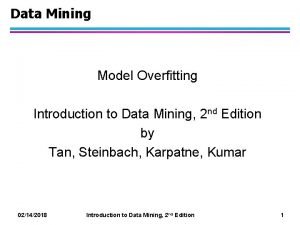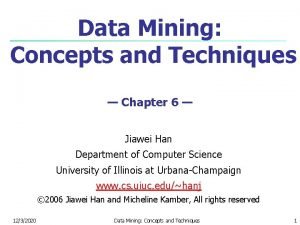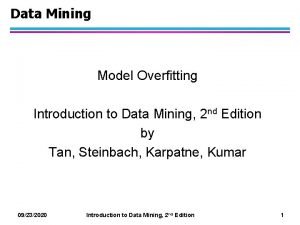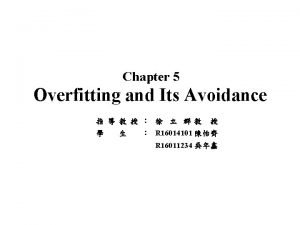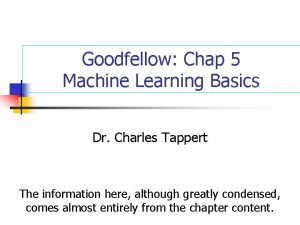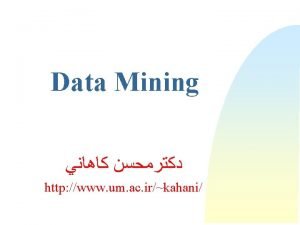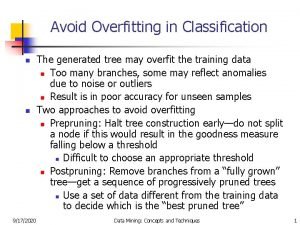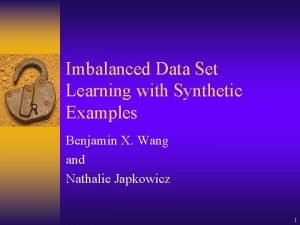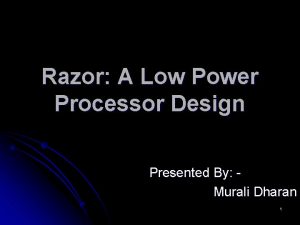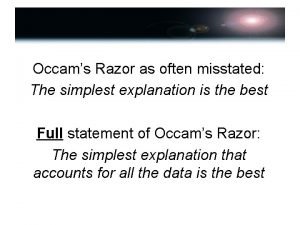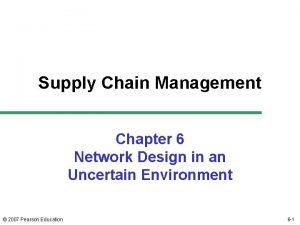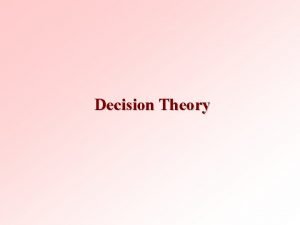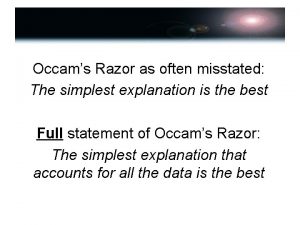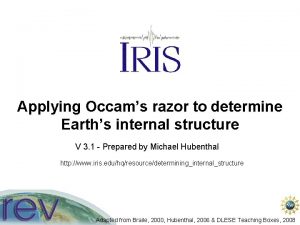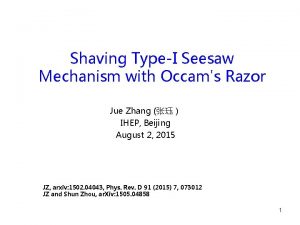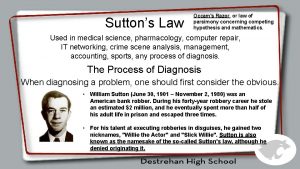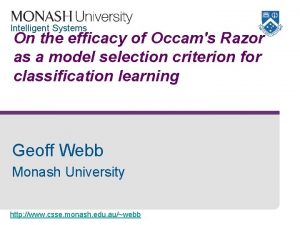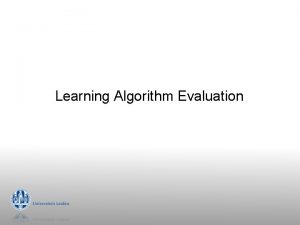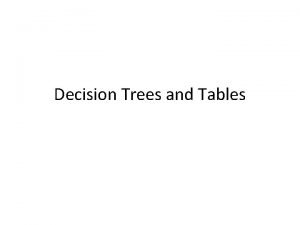Lecture 5 Decision Trees Occams Razor and Overfitting
























- Slides: 24

Lecture 5 Decision Trees, Occam’s Razor, and Overfitting Thursday, September 9, 1999 William H. Hsu Department of Computing and Information Sciences, KSU http: //www. cis. ksu. edu/~bhsu Readings: Chapter 3. 6 -3. 8, Mitchell CIS 798: Intelligent Systems and Machine Learning Kansas State University Department of Computing and Information Sciences

Lecture Outline • Read Sections 3. 6 -3. 8, Mitchell • Occam’s Razor and Decision Trees – Preference biases versus language biases – Two issues regarding Occam algorithms • Is Occam’s Razor well defined? • Why prefer smaller trees? • Overfitting (aka Overtraining) – Problem: fitting training data too closely • Small-sample statistics • General definition of overfitting – Overfitting prevention, avoidance, and recovery techniques • Prevention: attribute subset selection • Avoidance: cross-validation • Detection and recovery: post-pruning • Other Ways to Make Decision Tree Induction More Robust CIS 798: Intelligent Systems and Machine Learning Kansas State University Department of Computing and Information Sciences

Occam’s Razor and Decision Trees: A Preference Bias • Preference Biases versus Language Biases – Preference bias • Captured (“encoded”) in learning algorithm • Compare: search heuristic – Language bias • Captured (“encoded”) in knowledge (hypothesis) representation • Compare: restriction of search space • aka restriction bias • Occam’s Razor: Argument in Favor – Fewer short hypotheses than long hypotheses • e. g. , half as many bit strings of length n as of length n + 1, n 0 • Short hypothesis that fits data less likely to be coincidence • Long hypothesis (e. g. , tree with 200 nodes, |D| = 100) could be coincidence – Resulting justification / tradeoff • All other things being equal, complex models tend not to generalize as well • Assume more model flexibility (specificity) won’t be needed later CIS 798: Intelligent Systems and Machine Learning Kansas State University Department of Computing and Information Sciences

Occam’s Razor and Decision Trees: Two Issues • Occam’s Razor: Arguments Opposed – size(h) based on H - circular definition? – Objections to the preference bias: “fewer” not a justification • Is Occam’s Razor Well Defined? – Internal knowledge representation (KR) defines which h are “short” - arbitrary? – e. g. , single “(Sunny Normal-Humidity) Overcast (Rain Light-Wind)” test – Answer: L fixed; imagine that biases tend to evolve quickly, algorithms slowly • Why Short Hypotheses Rather Than Any Other Small H? – There are many ways to define small sets of hypotheses – For any size limit expressed by preference bias, some specification S restricts size(h) to that limit (i. e. , “accept trees that meet criterion S”) • e. g. , trees with a prime number of nodes that use attributes starting with “Z” • Why small trees and not trees that (for example) test A 1, …, A 11 in order? • What’s so special about small H based on size(h)? – Answer: stay tuned, more on this in Chapter 6, Mitchell CIS 798: Intelligent Systems and Machine Learning Kansas State University Department of Computing and Information Sciences

Overfitting in Decision Trees: An Example • Recall: Induced Tree 1, 2, 3, 4, 5, 6, 7, 8, 9, 10, 11, 12, 13, 14 Outlook? [9+, 5 -] Sunny 1, 2, 8, 9, 11 [2+, 3 -] Humidity? High Overcast Normal • No Yes Rain Yes Wind? 3, 7, 12, 13 [4+, 0 -] Strong No Temp? 1, 2, 8 9, 11, 15 [0+, 3 -] [2+, 1 -] Hot Mild Cool 15 [0+, 1 -] Boolean Decision Tree for Concept 4, 5, 6, 10, 14 Play. Tennis [3+, 2 -] No 6, 14 [0+, 2 -] Yes 11 [1+, 0 -] Light Yes 4, 5, 10 [3+, 0 -] 9 [1+, 0 -] May fit noise or other coincidental regularities Noisy Training Example – Example 15: <Sunny, Hot, Normal, Strong, -> • Example is noisy because the correct label is + • Previously constructed tree misclassifies it – How shall the DT be revised (incremental learning)? – New hypothesis h’ = T’ is expected to perform worse than h = T CIS 798: Intelligent Systems and Machine Learning Kansas State University Department of Computing and Information Sciences

Overfitting in Inductive Learning • Definition – Hypothesis h overfits training data set D if an alternative hypothesis h’ such that error. D(h) < error. D(h’) but errortest(h) > errortest(h’) – Causes: sample too small (decisions based on too little data); noise; coincidence • How Can We Combat Overfitting? – Analogy with computer virus infection, process deadlock – Prevention • Addressing the problem “before it happens” • Select attributes that are relevant (i. e. , will be useful in the model) • Caveat: chicken-egg problem; requires some predictive measure of relevance – Avoidance • Sidestepping the problem just when it is about to happen • Holding out a test set, stopping when h starts to do worse on it – Detection and Recovery • Letting the problem happen, detecting when it does, recovering afterward • Build model, remove (prune) elements that contribute to overfitting CIS 798: Intelligent Systems and Machine Learning Kansas State University Department of Computing and Information Sciences

Decision Tree Learning: Overfitting Prevention and Avoidance • How Can We Combat Overfitting? – Prevention (more on this later) • Select attributes that are relevant (i. e. , will be useful in the DT) • Predictive measure of relevance: attribute filter or subset selection wrapper – Avoidance Accuracy • Holding out a validation set, stopping when h T starts to do worse on it 0. 9 0. 85 0. 8 0. 75 0. 7 0. 65 0. 6 0. 55 0. 5 On training data On test data 0 10 20 30 40 50 60 70 80 90 100 Size of tree (number of nodes) • How to Select “Best” Model (Tree) – Measure performance over training data and separate validation set – Minimum Description Length (MDL): minimize size(h T) + size (misclassifications (h T)) CIS 798: Intelligent Systems and Machine Learning Kansas State University Department of Computing and Information Sciences

Decision Tree Learning: Overfitting Avoidance and Recovery • Today: Two Basic Approaches – Pre-pruning (avoidance): stop growing tree at some point during construction when it is determined that there is not enough data to make reliable choices – Post-pruning (recovery): grow the full tree and then remove nodes that seem not to have sufficient evidence • Methods for Evaluating Subtrees to Prune – Cross-validation: reserve hold-out set to evaluate utility of T (more in Chapter 4) – Statistical testing: test whether observed regularity can be dismissed as likely to have occurred by chance (more in Chapter 5) – Minimum Description Length (MDL) • Additional complexity of hypothesis T greater than that of remembering exceptions? • Tradeoff: coding model versus coding residual error CIS 798: Intelligent Systems and Machine Learning Kansas State University Department of Computing and Information Sciences

Reduced-Error Pruning • Post-Pruning, Cross-Validation Approach • Split Data into Training and Validation Sets • Function Prune(T, node) – Remove the subtree rooted at node – Make node a leaf (with majority label of associated examples) • Algorithm Reduced-Error-Pruning (D) – Partition D into Dtrain (training / “growing”), Dvalidation (validation / “pruning”) – Build complete tree T using ID 3 on Dtrain – UNTIL accuracy on Dvalidation decreases DO FOR each non-leaf node candidate in T Temp[candidate] Prune (T, candidate) Accuracy[candidate] Test (Temp[candidate], Dvalidation) T T’ Temp with best value of Accuracy (best increase; greedy) – RETURN (pruned) T CIS 798: Intelligent Systems and Machine Learning Kansas State University Department of Computing and Information Sciences

Effect of Reduced-Error Pruning Reduction of Test Error by Reduced-Error Pruning Accuracy • 0. 9 0. 85 0. 8 0. 75 0. 7 0. 65 0. 6 0. 55 0. 5 On training data On test data Post-pruned tree on test data 0 10 20 30 40 50 60 70 80 90 100 Size of tree (number of nodes) – Test error reduction achieved by pruning nodes – NB: here, Dvalidation is different from both Dtrain and Dtest • Pros and Cons – Pro: Produces smallest version of most accurate T’ (subtree of T) – Con: Uses less data to construct T • Can afford to hold out Dvalidation? • If not (data is too limited), may make error worse (insufficient Dtrain) CIS 798: Intelligent Systems and Machine Learning Kansas State University Department of Computing and Information Sciences

Rule Post-Pruning • Frequently Used Method – Popular anti-overfitting method; perhaps most popular pruning method – Variant used in C 4. 5, an outgrowth of ID 3 • Algorithm Rule-Post-Pruning (D) – Infer T from D (using ID 3) - grow until D is fit as well as possible (allow overfitting) – Convert T into equivalent set of rules (one for each root-to-leaf path) – Prune (generalize) each rule independently by deleting any preconditions whose deletion improves its estimated accuracy – Sort the pruned rules • Sort by their estimated accuracy • Apply them in sequence on Dtest CIS 798: Intelligent Systems and Machine Learning Kansas State University Department of Computing and Information Sciences

Converting a Decision Tree into Rules • Rule Syntax – LHS: precondition (conjunctive formula over attribute equality tests) – RHS: class label Outlook? Sunny Humidity? High No • Boolean Decision Tree for Concept Play. Tennis Overcast Rain Wind? Yes Normal Yes Strong No Light Yes Example – IF (Outlook = Sunny) (Humidity = High) THEN Play. Tennis = No – IF (Outlook = Sunny) (Humidity = Normal) THEN Play. Tennis = Yes – … CIS 798: Intelligent Systems and Machine Learning Kansas State University Department of Computing and Information Sciences

Continuous Valued Attributes • Two Methods for Handling Continuous Attributes – Discretization (e. g. , histogramming) • Break real-valued attributes into ranges in advance • e. g. , {high Temp > 35º C, med 10º C < Temp 35º C, low Temp 10º C} – Using thresholds for splitting nodes • e. g. , A a produces subsets A a and A > a • Information gain is calculated the same way as for discrete splits • How to Find the Split with Highest Gain? – FOR each continuous attribute A Divide examples {x D} according to x. A FOR each ordered pair of values (l, u) of A with different labels Evaluate gain of mid-point as a possible threshold, i. e. , DA (l+u)/2, DA > (l+u)/2 – Example • A Length: 10 15 21 28 32 40 50 • Class: - + + - 24. 5? 30? 45? • Check thresholds: Length 12. 5? CIS 798: Intelligent Systems and Machine Learning Kansas State University Department of Computing and Information Sciences

Attributes with Many Values • Problem – If attribute has many values, Gain( • ) will select it (why? ) – Imagine using Date = 06/03/1996 as an attribute! • One Approach: Use Gain. Ratio instead of Gain – Split. Information: directly proportional to c = | values(A) | – i. e. , penalizes attributes with more values • e. g. , suppose c 1 = c. Date = n and c 2 = 2 • Split. Information (A 1) = lg(n), Split. Information (A 2) = 1 • If Gain(D, A 1) = Gain(D, A 2), Gain. Ratio (D, A 1) << Gain. Ratio (D, A 2) – Thus, preference bias (for lower branch factor) expressed via Gain. Ratio( • ) CIS 798: Intelligent Systems and Machine Learning Kansas State University Department of Computing and Information Sciences

Attributes with Costs • Application Domains – Medical: Temperature has cost $10; Blood. Test. Result, $150; Biopsy, $300 • Also need to take into account invasiveness of the procedure (patient utility) • Risk to patient (e. g. , amniocentesis) – Other units of cost • Sampling time: e. g. , robot sonar (range finding, etc. ) • Risk to artifacts, organisms (about which information is being gathered) • Related domains (e. g. , tomography): nondestructive evaluation • How to Learn A Consistent Tree with Low Expected Cost? – One approach: replace gain by Cost-Normalized-Gain – Examples of normalization functions • [Nunez, 1988]: • [Tan and Schlimmer, 1990]: where w determines importance of cost CIS 798: Intelligent Systems and Machine Learning Kansas State University Department of Computing and Information Sciences

Missing Data: Unknown Attribute Values • Problem: What If Some Examples Missing Values of A? – Often, values not available for all attributes during training or testing – Example: medical diagnosis • <Fever = true, Blood-Pressure = normal, …, Blood-Test = ? , …> • Sometimes values truly unknown, sometimes low priority (or cost too high) – Missing values in learning versus classification • Training: evaluate Gain (D, A) where for some x D, a value for A is not given • Testing: classify a new example x without knowing the value of A • Solutions: Incorporating a Guess into Calculation of Gain(D, A) [9+, 5 -] Outlook Sunny [2+, 3 -] CIS 798: Intelligent Systems and Machine Learning Overcast [4+, 0 -] Rain [3+, 2 -] Kansas State University Department of Computing and Information Sciences

Missing Data: Solution Approaches • Use Training Example Anyway, Sort Through Tree – For each attribute being considered, guess its value in examples where unknown – Base the guess upon examples at current node where value is known • Guess the Most Likely Value of x. A – Variation 1: if node n tests A, assign most common value of A among other examples routed to node n – Variation 2 [Mingers, 1989]: if node n tests A, assign most common value of A among other examples routed to node n that have the same class label as x • Distribute the Guess Proportionately – Hedge the bet: distribute the guess according to distribution of values – Assign probability pi to each possible value vi of x. A [Quinlan, 1993] • Assign fraction pi of x to each descendant in the tree • Use this in calculating Gain (D, A) or Cost-Normalized-Gain (D, A) • In All Approaches, Classify New Examples in Same Fashion CIS 798: Intelligent Systems and Machine Learning Kansas State University Department of Computing and Information Sciences

Missing Data: An Example • Guess the Most Likely Value of x. A – Variation 1: Humidity = High or Normal (High: Gain = 0. 97, Normal: < 0. 97) – Variation 2: Humidity = High (all No cases are High) 1, 2, 3, 4, 5, 6, 7, 8, 9, 10, 11, 12, 13, 14 [9+, 5 -] Outlook? • Probabilistically Weighted Guess – Guess 0. 5 High, 0. 5 Normal Sunny 1, 2, 8, 9, 11 [2+, 3 -] Test Case: <? , Hot, Normal, Strong> – 1/3 Yes + 1/3 No = Yes High Rain Yes Humidity? – Gain < 0. 97 • Overcast 3, 7, 12, 13 [4+, 0 -] Normal Wind? Strong 4, 5, 6, 10, 14 [3+, 2 -] Light No Yes 1, 2, 8 [0+, 3 -] 9, 11 [2+, 0 -] 6, 14 [0+, 2 -] 4, 5, 10 [3+, 0 -] CIS 798: Intelligent Systems and Machine Learning Kansas State University Department of Computing and Information Sciences

Replication in Decision Trees • Decision Trees: A Representational Disadvantage – DTs are more complex than some other representations – Case in point: replications of attributes • Replication Example – e. g. , Disjunctive Normal Form (DNF): (a b) (c d e) – Disjuncts must be repeated as subtrees • Partial Solution Approach – Creation of new features c? 0 - – aka constructive induction (CI) – More on CI in Chapter 10, Mitchell a? 0 0 0 - e? 1 1 0 d? c? 1 + 1 0 - CIS 798: Intelligent Systems and Machine Learning b? + 1 0 e? d? 1 1 - + Kansas State University Department of Computing and Information Sciences

Fringe: Constructive Induction in Decision Trees • Synthesizing New Attributes – Synthesize (create) a new attribute from the conjunction of the last two attributes before a + node – aka feature construction • c? 0 Example - – (a b) (c d e) 0 – A = d e - 0 – Correctness? - C? c? 0 0 1 0 d? c? 1 0 - 1 + B? 0 – C=A c – Computation? 1 0 - Repeated application 0 e? 0 – B=a b • a? 0 B? 1 b? + 1 0 e? d? 1 1 - + 1 A? - 1 + + 1 + CIS 798: Intelligent Systems and Machine Learning Kansas State University Department of Computing and Information Sciences

Other Issues and Open Problems • Still to Cover – What is the goal (performance element)? Evaluation criterion? – When to stop? How to guarantee good generalization? – How are we doing? • Correctness • Complexity • Oblique Decision Trees – Decisions are not “axis-parallel” – See: OC 1 (included in MLC++) • Incremental Decision Tree Induction – Update an existing decision tree to account for new examples incrementally – Consistency issues – Minimality issues CIS 798: Intelligent Systems and Machine Learning Kansas State University Department of Computing and Information Sciences

History of Decision Tree Research to Date • 1960’s – 1966: Hunt, colleagues in psychology used full search decision tree methods to model human concept learning • 1970’s – 1977: Breiman, Friedman, colleagues in statistics develop simultaneous Classification And Regression Trees (CART) – 1979: Quinlan’s first work with proto-ID 3 • 1980’s – 1984: first mass publication of CART software (now in many commercial codes) – 1986: Quinlan’s landmark paper on ID 3 – Variety of improvements: coping with noise, continuous attributes, missing data, non-axis-parallel DTs, etc. • 1990’s – 1993: Quinlan’s updated algorithm, C 4. 5 – More pruning, overfitting control heuristics (C 5. 0, etc. ); combining DTs CIS 798: Intelligent Systems and Machine Learning Kansas State University Department of Computing and Information Sciences

Terminology • Occam’s Razor and Decision Trees – Preference biases: captured by hypothesis space search algorithm – Language biases : captured by hypothesis language (search space definition) • Overfitting – Overfitting: h does better than h’ on training data and worse on test data – Prevention, avoidance, and recovery techniques • Prevention: attribute subset selection • Avoidance: stopping (termination) criteria, cross-validation, pre-pruning • Detection and recovery: post-pruning (reduced-error, rule) • Other Ways to Make Decision Tree Induction More Robust – Inequality DTs (decision surfaces): a way to deal with continuous attributes – Information gain ratio: a way to normalize against many-valued attributes – Cost-normalized gain: a way to account for attribute costs (utilities) – Missing data: unknown attribute values or values not yet collected – Feature construction: form of constructive induction; produces new attributes – Replication: repeated attributes in DTs CIS 798: Intelligent Systems and Machine Learning Kansas State University Department of Computing and Information Sciences

Summary Points • Occam’s Razor and Decision Trees – Preference biases versus language biases – Two issues regarding Occam algorithms • Why prefer smaller trees? (less chance of “coincidence”) • Is Occam’s Razor well defined? (yes, under certain assumptions) – MDL principle and Occam’s Razor: more to come • Overfitting – Problem: fitting training data too closely • General definition of overfitting • Why it happens – Overfitting prevention, avoidance, and recovery techniques • Other Ways to Make Decision Tree Induction More Robust • Next Week: Perceptrons, Neural Nets (Multi-Layer Perceptrons), Winnow CIS 798: Intelligent Systems and Machine Learning Kansas State University Department of Computing and Information Sciences
 No decision snap decision responsible decision
No decision snap decision responsible decision Financial management process
Financial management process Underfitting and overfitting in data mining
Underfitting and overfitting in data mining Overfitting and underfitting in data mining
Overfitting and underfitting in data mining Data mining overfitting
Data mining overfitting Churn avoidance
Churn avoidance Overfitting loss curve
Overfitting loss curve Ian goodfellow mlschifferzoeschiffer
Ian goodfellow mlschifferzoeschiffer Overfitting in data mining
Overfitting in data mining Nn overfitting
Nn overfitting Smote overfitting
Smote overfitting 01:640:244 lecture notes - lecture 15: plat, idah, farad
01:640:244 lecture notes - lecture 15: plat, idah, farad Occam's razor examples
Occam's razor examples Clean edge razor: splitting hairs in product positioning
Clean edge razor: splitting hairs in product positioning How do mussels reproduce
How do mussels reproduce Parts of shears milady
Parts of shears milady Defendor razor
Defendor razor Razor processor
Razor processor Ocams razor
Ocams razor Czech blades s.r.o
Czech blades s.r.o Decision tree in supply chain management
Decision tree in supply chain management Criterion of realism (hurwicz)
Criterion of realism (hurwicz) What is data and process modeling
What is data and process modeling Bayesian decision theory lecture notes
Bayesian decision theory lecture notes Sargur srihari
Sargur srihari


